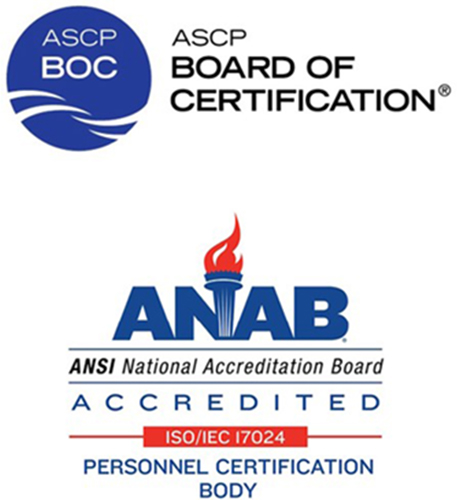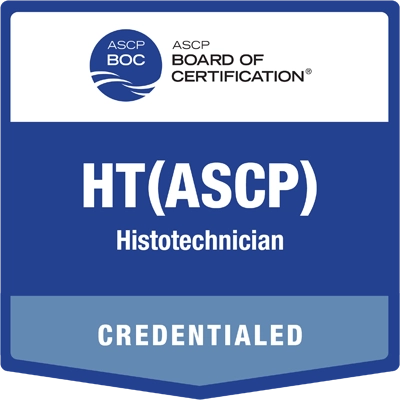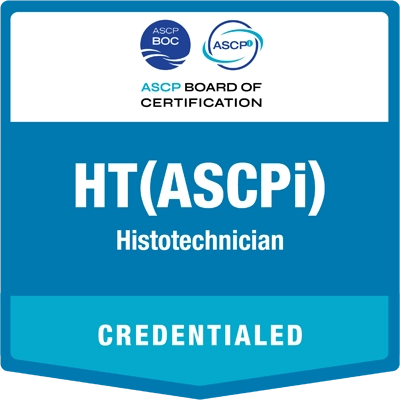Obtain certification and advance your career in histology with our specialized credential.
Prepares and processes tissue samples for routine histologic techniques to be examined under a microscope by a pathologist. The histologic techniques include the following: fixation, processing, embedding, microtomy, and staining of human and animal tissue for evaluation.
Attaining an American Society for Clinical Pathology Board of Certification (ASCP BOC) credential requires a laboratory professional or other expert to meet specific education, training, and/or experience standards and to successfully pass an examination demonstrating knowledge and applied skills. The ASCP BOC offers ASCP and ASCPi credentials based on distinct eligibility requirements. All candidates must carefully compare credentialing options. Additional information is available about the similarities and differences between ASCP and ASCPi credentials.
Each credential has specific eligibility requirements, which are different for ASCP and ASCPi. It’s your responsibility to confirm that your education, training, and/or experience meet the criteria. Submit the correct documentation with your application. Once submitted, the category and route of application cannot be changed.
Check Your EligibilityAn applicant must be able to verify that they meet all eligibility requirements, including education, training, and/or experience. For complete information, see the Documentation section of the website.
Education does not need to be from the United States. Details are available by reviewing the webpage titled Acceptable Education, also available in the routes below.
To be eligible for this examination category, an applicant must satisfy the minimum requirements (for degrees, the stated degree or higher) of at least one of the following routes:
An applicant must be able to verify that they meet all eligibility requirements, including education, training, and/or experience. For complete information, see the Documentation section of the website.
Education needs to be equivalent to education from the United States. Details are available by reviewing the webpage titled Acceptable Education, also available in the routes below.
To be eligible for this examination category, an applicant must satisfy the minimum requirements (for degrees, the stated degree or higher) of at least one of the following routes:


*Acceptable Clinical Laboratory:
CMS CLIA certificate of registration, compliance, accreditation;
OR DoD CLIP certificate of registration, compliance, accreditation;
OR JCI accreditation;
OR Accreditation under ISO 15189.
Experience
To fulfill the experience requirement for the Histotechnician examination, you must have experience within the last 5 years in ALL of the following areas:
FIXATION
PROCESSING
EMBEDDING / MICROTOMY
STAINING
LABORATORY OPERATIONS
60 semester hours (90 quarter hours) of academic credit from an accredited (regionally or nationally) college/university, with a combination of 12 semester hours (18 quarter hours) in biology and chemistry (must include credit hours in both), OR an associate degree from an accredited (regionally or nationally) college/university, with a combination of 12 semester hours (18 quarter hours) in biology and chemistry (must include credit hours in both), which may be obtained within, or in addition to, the associate degree,
AND successful completion of a 50-week U.S. military histotechnician training course# within the last 10 years.
#Official documentation of your military code (NEC, MOS, AFSC code or 68K), official certificate verifying completion of training, or an official copy of your DD214 form, SRB, or ERB must be uploaded in PDF format as part of completing the online application.
High school completion or equivalent,
AND successful completion of an accredited/approved* Histotechnician clinical training program which includes an internship in histotechnology. This histotechnician clinical training program and internship must be completed after high school completion and must be documented on this Training Documentation Form.
*Accredited/approved by a governing regulatory association or Ministry. Countries without a prevalent system of accreditation/approval must have programs/educational institutions approved by an International Advisory Board appointed by the ASCP Board of Certification, or eligibility will be determined by an acceptable transcript evaluation. The foreign degree must be equivalent to a U.S. degree.
Two-year diploma from an accredited/approved* educational institution,
AND 1 year of acceptable clinical# experience in a histopathology laboratory that must be documented on this Experience Documentation Form OR 1 year of acceptable veterinary, industry, or research experience in a histopathology laboratory that must be documented on this Experience Documentation Form.
*Accredited/approved by a governing regulatory association or Ministry. Countries without a prevalent system of accreditation/approval must have programs/educational institutions approved by an International Advisory Board appointed by the ASCP Board of Certification, or eligibility will be determined by an acceptable transcript evaluation. The foreign degree must be equivalent to a U.S. degree.
#Clinical laboratory accredited by JCI, CAP, under ISO 15189 or authorized by a governing regulatory association or Ministry. Countries without a prevalent system of accreditation must have laboratories approved by an International Advisory Board appointed by the ASCP Board of Certification.
Experience
To fulfill the experience requirement for the Histotechnician examination, you must have experience within the last 5 years in ALL of the following areas:
FIXATION
PROCESSING
EMBEDDING / MICROTOMY
STAINING
LABORATORY OPERATIONS
Beginning January 1, 2026, application fees for all ASCP certification examinations will increase by $10.
Reduced pricing is available for those educated and residing in low-to-middle income countries.
Beginning January 1, 2026, application fees for all ASCPi certification examinations will increase by $10, except for those educated and residing in low-to-middle income countries.
You must upload the appropriate documentation form when you apply online, verifying that you meet the training and/or experience requirements for your category and route of application. You will also need to submit an acceptable transcript or transcript evaluation verifying that you meet the academic requirements. Gather your documents before submitting your application and application fee.
Once you have confirmed that you meet the requirements and have gathered your documents, submit your online application.
 |  |
In early 2026, the ASCP BOC will launch digital badging through Credly, a trusted provider that increases the visibility of ASCP BOC credential holders by securely showcasing and sharing professional credentials. Learn more about digital badges.